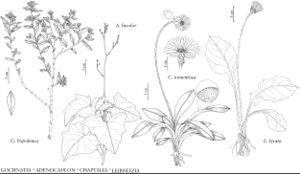Chaptalia
Descr. Pl. Nouv., plate 61. 1802.
| Taxon | Illustrator ⠉ | |
|---|---|---|
 | Gochnatia hypoleuca Adenocaulon bicolor Chaptalia tomentosa Leibnitzia lyrata | Yevonn Wilson-Ramsey Yevonn Wilson-Ramsey Yevonn Wilson-Ramsey Yevonn Wilson-Ramsey |
Perennials, 3–40 (–100) cm (fibrous-rooted, sometimes rhizomatous; stems ± scapiform). Leaves basal; sessile or ± petiolate; blades elliptic or elliptic-obovate to obovate, obovate-elliptic, ovate, or sublyrate, bases cuneate, margins entire or denticulate, serrulate, or dentate to lobed, abaxial faces usually covered with dense wool, adaxial faces glabrous or glabrescent. Heads quasi-radiate or ± disciform (see florets; chasmogamous, produced well after rosette leaves, erect in flowering, nodding or erect in bud and again in fruit), borne singly. Involucres cylindric to campanulate, (7–) 9–15+ mm (larger in fruit). Phyllaries in 2–5+ series, lanceolate to lance-linear, unequal, apices acute. Receptacles flat to convex, foveolate or smooth, glabrous, epaleate. Florets (dimorphic or trimorphic in 1–2 outer, pistillate-zones plus 1 inner, bisexual or functionally staminate zone): outer pistillate-zone florets 9–38 (–90+) in 1–2 (–3) series, fertile, corollas creamy white to purple (sometimes with adaxial midstripe), zygomorphic (liguliform or bilabiate, inner lip often bifurcate, limbs sometimes reduced, style-branches terete and linear to flattened and oblong); inner pistillate-zone florets 0 or 3–50 in 1–2 series, fertile, corollas usually ± zygomorphic (with reduced laminae and inner lips), sometimes reduced to tubes; innermost florets usually bisexual and fertile, sometimes functionally staminate, 15–40, corollas whitish to pinkish, usually zygomorphic (2-lipped, lobes recurved or coiling), sometimes nearly actinomorphic (lobes ± equal or lobes ± 0); anther basal appendages entire, apical appendages lanceolate; style-branches relatively short (abaxially pilose). Cypselae fusiform, often slightly flattened, distally ± tapered into necks or beaks (0.5–1.6 [–3] times bodies), ribs mostly 4–12, faces glabrous or hairy (hairs duplex, relatively short, apices rounded to apiculate), not glandular; pappi of 50+ stramineous to pinkish, barbellulate bristles. x = 24.
Distribution
North America, Central America, South America
Discussion
Species ca. 60 (3 in the flora).
Selected References
Lower Taxa
Key
| 1 | Heads erect in bud, flowering, and fruit; peduncles dilated distally; laminae of pistillate corollas 0.2–0.3 mm wide | Chaptalia albicans |
| 1 | Heads nodding in bud and fruit, erect in flowering; peduncles not dilated distally; laminae of pistillate corollas 0.2–1.5 mm wide | > 2 |
| 2 | Leaves petiolate, blades mostly obovate to sublyrate; laminae of pistillate corollas evenly cream-colored (turning to crimson); central florets bisexual, fertile; uplands, Texas, New Mexico | Chaptalia texana |
| 2 | Leaves sessile, blades elliptic to elliptic-obovate; laminae of pistillate corollas creamy white with purple, abaxial midstripe; central florets functionally staminate; coastal plain, North Carolina to Texas | Chaptalia tomentosa |